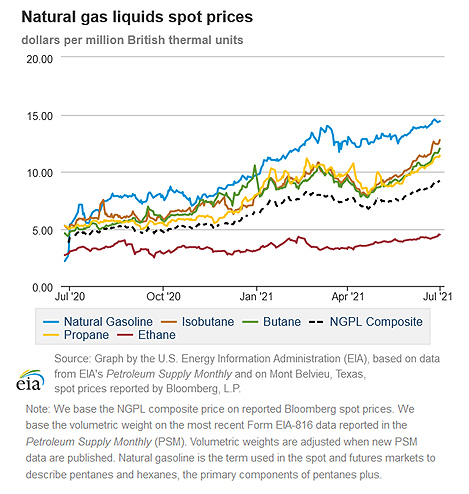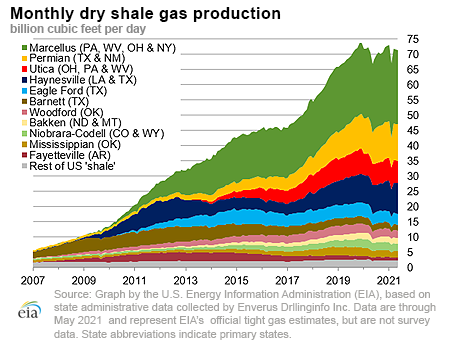In the News:
Growth in global LNG trade was flat in 2020
Global trade in liquefied natural gas (LNG) in 2020 remained essentially unchanged from 2019, averaging 46.9 billion cubic feet per day (Bcf/d) compared with 46.7 Bcf/d in 2019 (a 0.4% increase), according to the recently released The LNG Industry GIIGNL Annual Report 2021 by the International Group of Liquefied Natural Gas Importers (GIIGNL). This small annual increase in LNG trade occurred despite the COVID-19 pandemic that reduced global natural gas demand. Between 2015 and 2019, global LNG trade expanded by 45%, posting record growth in 2018 and 2019. This expansion was primarily led by liquefaction capacity additions in Australia, the United States, and Russia, which combined accounted for more than 90% of the global growth in liquefaction capacity during this period.
In 2020, LNG exports increased from only two countries—the United States and Australia—by 1.5 Bcf/d and 0.3 Bcf/d, respectively, compared with 2019. Last year, the United States commissioned several new liquefaction units (called trains), namely the third and final trains at each of the following U.S. LNG exports facilities—Cameron LNG, Freeport LNG, Corpus Christi LNG—and the remaining liquefaction units at Elba Island LNG. U.S. LNG exports significantly declined in June and July of 2020, following the onset of COVID-19 pandemic, but they have gradually recovered in the months that followed and set consecutive all-time records in November and December 2020. Also in 2020, Australia became the world’s largest LNG exporter for the first time, overtaking Qatar, with exports averaging 10.2 Bcf/d, an increase of 0.3 Bcf/d (3%) over the prior year. Exports from Qatar have declined by 0.1 Bcf/d (1%), while exports from all other countries have either remained flat or declined, amounting to a combined 1.6 Bcf/d decrease compared with 2019.
Among all LNG-importing regions, only Asia posted an increase in annual LNG imports, by 1.1 Bcf/d (3%), in 2020 compared with 2019. The largest year-on-year increases in LNG imports were in China (by 1.0 Bcf/d) and India (by 0.4 Bcf/d). In China, continuous growth in LNG imports was mainly the result of government-supported coal-to-natural gas switching policies to reduce air pollution. In India, all-time low spot LNG prices in the spring and summer months of 2020 led to increased fuel switching and additional LNG imports procured on a spot basis. LNG imports to Japan continued to decline in 2020, averaging 9.8 Bcf/d, which was 0.3 Bcf/d lower than in 2019.
LNG imports in Europe declined by 0.6 Bcf/d (5%) compared with 2019, averaging 10.7 Bcf/d, but remained significantly higher than the 6.4 Bcf/d annual average in 2018. The largest year-over-year declines in LNG imports to Europe were in France (0.3 Bcf/d), Belgium (0.25 Bcf/d), and Italy (0.1 Bcf/d), while LNG imports to all other European countries except Turkey declined minimally or remained flat year on year. Turkey was the only country in Europe that increased LNG imports in 2020, by 0.2 Bcf/d (14%), over the prior year. LNG imports to countries in Latin America decreased by 0.3 Bcf/d (17%) and remained essentially flat in the Middle East, averaging 0.9 Bcf/d, 1% lower than in 2019.
Overview:
(For the week ending Wednesday, June 30, 2021)
- Natural gas spot prices rose at most locations this report week (Wednesday, June 23, to Wednesday, June 30). The Henry Hub spot price rose from $3.33 per million British thermal units (MMBtu) last Wednesday to $3.72/MMBtu yesterday.
- The July 2021 NYMEX contract expired Monday at $3.617/MMBtu, up 28¢/MMBtu from last Wednesday. The August 2021 NYMEX contract price increased to $3.650/MMBtu, up 30¢/MMBtu from last Wednesday to yesterday. The price of the futures contracts for the 12-month strip averaging August 2021 through July 2022 climbed 21¢/MMBtu to $3.429/MMBtu.
- The net injections to working gas totaled 76 billion cubic feet (Bcf) for the week ending June 25. Working natural gas stocks totaled 2,558 Bcf, which is 17% lower than the year-ago level and 5% lower than the five-year (2016–2020) average for this week.
- The natural gas plant liquids composite price at Mont Belvieu, Texas, rose by 44¢/MMBtu, averaging $9.07/MMBtu for the week ending June 30. Ethane prices rose 4%, less than the 11% price increase in natural gas at the Houston Ship Channel. The ethane premium to natural gas at heat-value parity decreased by 17% compared with the previous week. Propane prices rose 6%, and normal butane and isobutane prices both increased by 7%, as a result of elevated exports of these three fuels this summer. The price of natural gasoline rose 2%, slightly more than Brent crude oil, which increased 1%.
- According to Baker Hughes, for the week ending Tuesday, June 22, the natural gas rig count increased by 1 to 98. The number of oil-directed rigs fell by 1 to 372. The total rig count stayed at 470.
Prices/Supply/Demand:
Gulf Coast prices increase as natural gas remains the main source for power generation in Texas. This report week (Wednesday, June 23, to Wednesday, June 30), the Henry Hub spot price rose 39¢ from $3.33/MMBtu last Wednesday to $3.72/MMBtu yesterday. Net electricity generation in the Electric Reliability Council of Texas (ERCOT) remained elevated this report week, and natural gas was ERCOT’s leading generation source as electricity generation from wind has declined recently.
Prices in Southern California increase more than $1/MMBtu this week as high temperatures continue. The price at PG&E Citygate in Northern California rose 18¢, up from $4.87/MMBtu last Wednesday to $5.05/MMBtu yesterday. Natural gas demand for power generation in the Pacific Northwest increased 30% this report week, according to data from IHS Markit. Extreme heat in the region is causing utility companies to call for rolling blackouts to conserve energy.
The price at SoCal Citygate in Southern California increased $1.36 from $4.09/MMBtu last Wednesday to $5.45/MMBtu yesterday. Temperatures were higher than normal in Southern California as well, prompting higher demand for natural gas for electricity generation for cooling.
Midwest prices increase as natural gas for power generation makes up for low wind generation. At the Chicago Citygate, the price increased 40¢ from $3.16/MMBtu last Wednesday to $3.56/MMBtu yesterday. Natural gas consumed in the electric power sector increased 31% week over week in the Midcontinent, according to data from IHS Markit. Wind generation in the Midcontinent Independent System Operator (MISO) and in the Southwest Power Pool (SPP) was low this week compared with last week, prompting more generation from other sources, especially natural gas.
The Northeast experienced higher than normal temperatures, prompting increases in prices. At the Algonquin Citygate, which serves Boston-area consumers, the price went up $1.57 from $2.62/MMBtu last Wednesday to $4.19/MMBtu yesterday. High temperatures in the Northeast led to a week-over-week increase in power demand of 28%, according to data from IHS Markit. At the Transcontinental Pipeline Zone 6 trading point for New York City, the price increased 74¢ from $2.45/MMBtu last Wednesday to $3.19/MMBtu yesterday. In New York, where temperatures reached highs of 98°F this report week, the New York Independent Service Operator (NYISO) activated Emergency Demand Response Procedure (EDRP) resources in some locations.
Prices in the Appalachia Basin increase along with consumption of natural gas in the electric power sector. The Tennessee Zone 4 Marcellus spot price increased 20¢ from $2.39/MMBtu last Wednesday to $2.59/MMBtu yesterday as demand for natural gas in the electric power sector in the Appalachia region increased 28% this week, according to data from IHS Markit. The price at Eastern Gas South (formerly known as Dominion South until June 1, 2021) in southwest Pennsylvania rose 35¢ from $2.46/MMBtu last Wednesday to $2.81/MMBtu yesterday. Temperatures in Pittsburgh, Pennsylvania, reached highs of 92°F this week, 10°F higher than normal.
Permian Basin prices increase because of increased demand for natural gas in the West. The price at the Waha Hub in West Texas, which is located near Permian Basin production activities, averaged $2.66/MMBtu last Wednesday, 67¢/MMBtu lower than the Henry Hub price. Prices at the Waha hub increased this week because of high demand for natural gas in California for electricity generation amid extreme heat in the West. Yesterday, the price at the Waha Hub averaged $3.53/MMBtu, 19¢/MMBtu lower than the Henry Hub price.
Net imports from Canada increase. According to data from IHS Markit, the average total U.S. supply of natural gas fell slightly by 0.1% compared with the previous report week. Dry natural gas production decreased by 0.4% compared with the previous report week to average 92.7 Bcf/d. Average net imports from Canada increased by 4.8% from last week. Construction delays for planned maintenance on the Gas Transmission Northwest pipeline prompted TC Energy to increase the available flow capacity past the Kingsgate location from 1,865 million cubic feet per day (MMcf/d) to 2,400 MMcf/d. TC Energy had increased the flow rate at that location earlier in the week as well, citing “high ambient temperatures and pipeline conditions.”
U.S. consumption of natural gas increases driven by demand for power generation. Total U.S. consumption of natural gas rose by 6.0% compared with the previous report week, according to data from IHS Markit. Natural gas consumed for power generation climbed by 10.5% week over week as much of the United States experienced temperatures much higher than normal, especially in the Pacific Northwest. Industrial sector consumption decreased slightly by 0.4% week over week. In the residential and commercial sectors, consumption increased by 2.8%. Natural gas exports to Mexico decreased 7.7%, partly as a result of planned maintenance on the Valley Crossing pipeline at the Agua Dulce and Brownsville compressor stations. Natural gas deliveries to U.S. liquefied natural gas (LNG) export facilities (LNG pipeline receipts) averaged 11.1 Bcf/d, or 1.09 Bcf/d higher than last week.
U.S. LNG exports increase week over week. Twenty-one LNG vessels (seven from Sabine Pass, five from Corpus Christi, four from Freeport, three from Cameron, and one each from Cove Point and from Elba Island) with a combined LNG-carrying capacity of 76 Bcf departed the United States between June 24 and June 30, 2021, according to shipping data provided by Bloomberg Finance, L.P. Two tankers were loading on Wednesday—one each at Cameron and Sabine Pass.
Storage:
The net injections into storage totaled 76 Bcf for the week ending June 25, compared with the five-year (2016–2020) average net injections of 65 Bcf and last year's net injections of 73 Bcf during the same week. Working natural gas stocks totaled 2,558 Bcf, which is 143 Bcf lower than the five-year average and 510 Bcf lower than last year at this time.
According to The Desk survey of natural gas analysts, estimates of the weekly net change to working natural gas stocks ranged from net injections of 59 Bcf to 75 Bcf, with a median estimate of 68 Bcf.
The average rate of injections into storage is 13% lower than the five-year average so far in the refill season (April through October). If the rate of injections into storage matched the five-year average of 8.0 Bcf/d for the remainder of the refill season, the total inventory would be 3,576 Bcf on October 31, which is 143 Bcf lower than the five-year average of 3,719 Bcf for that time of year.
More storage data and analysis can be found on the Natural Gas Storage Dashboard and the Weekly Natural Gas Storage Report.
See also:
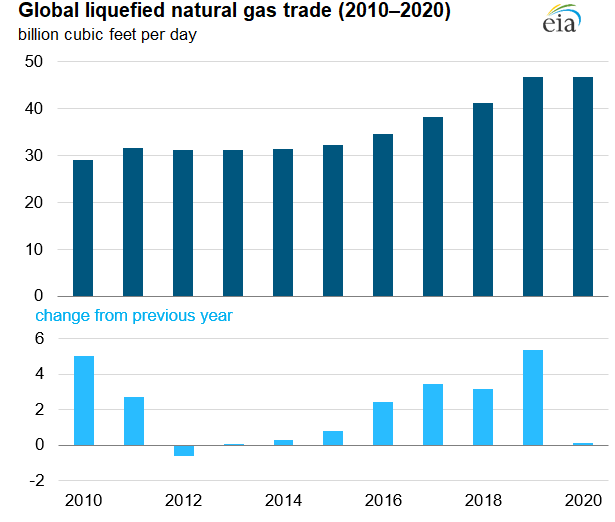 Source: Graph created by the U.S. Energy Information Administration, based on data from the International Group of Liquefied Natural Gas Importers (GIIGNL)’s The LNG Industry annual reports (2010–2021)
Source: Graph created by the U.S. Energy Information Administration, based on data from the International Group of Liquefied Natural Gas Importers (GIIGNL)’s The LNG Industry annual reports (2010–2021)
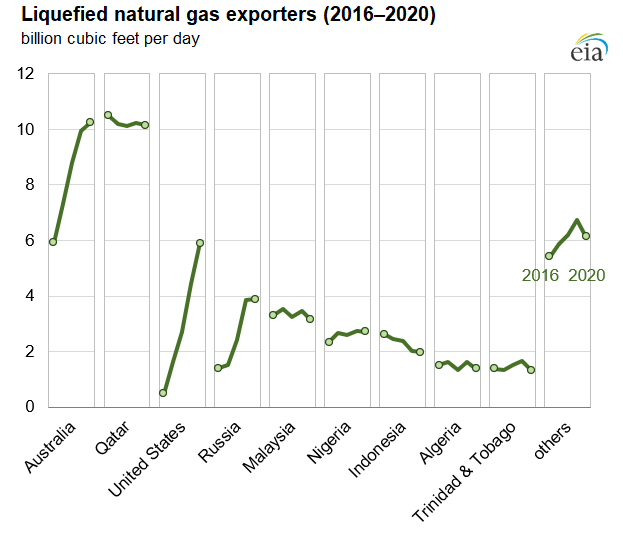 Source: Graph created by the U.S. Energy Information Administration, based on data from the International Group of Liquefied Natural Gas Importers (GIIGNL)’s The LNG Industry annual reports (2017–2021)
Source: Graph created by the U.S. Energy Information Administration, based on data from the International Group of Liquefied Natural Gas Importers (GIIGNL)’s The LNG Industry annual reports (2017–2021)
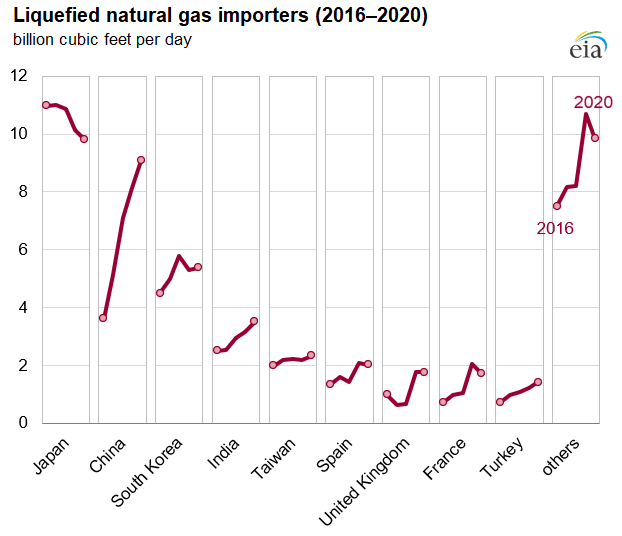 Source: Graph created by the U.S. Energy Information Administration, based on data from the International Group of Liquefied Natural Gas Importers (GIIGNL)’s The LNG Industry annual reports (2017–2021)
Source: Graph created by the U.S. Energy Information Administration, based on data from the International Group of Liquefied Natural Gas Importers (GIIGNL)’s The LNG Industry annual reports (2017–2021)
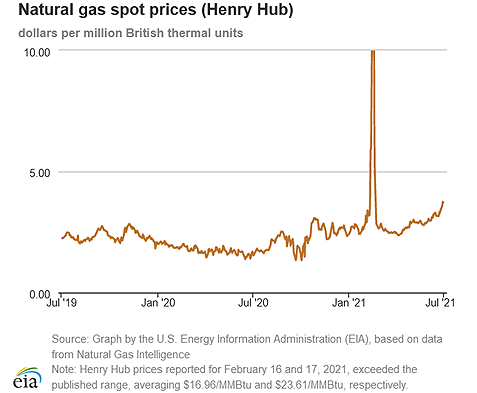
| Spot Prices ($/MMBtu) | Thu, 24-Jun |
Fri, 25-Jun |
Mon, 28-Jun |
Tue, 29-Jun |
Wed, 30-Jun |
|---|---|---|---|---|---|
| Henry Hub | 3.30 | 3.41 | 3.57 | 3.74 | 3.72 |
| New York | 2.65 | 3.14 | 3.92 | 3.96 | 3.19 |
| Chicago | 3.20 | 3.34 | 3.60 | 3.75 | 3.56 |
| Cal. Comp. Avg,* | 4.02 | 4.31 | 4.80 | 4.92 | 4.43 |
| Futures ($/MMBtu) | |||||
| July Contract | 3.418 | 3.496 | 3.617 | Expired | Expired |
| August Contract | 3.437 | 3.520 | 3.593 | 3.630 | 3.650 |
| September Contract | 3.415 | 3.500 | 3.572 | 3.606 | 3.624 |
*Avg. of NGI's reported prices for: Malin, PG&E Citygate, and Southern California Border Avg. Source: Graph by the U.S. Energy Information Administration (EIA), based on data from Natural Gas Intelligence Daily Gas Price Index |
|||||
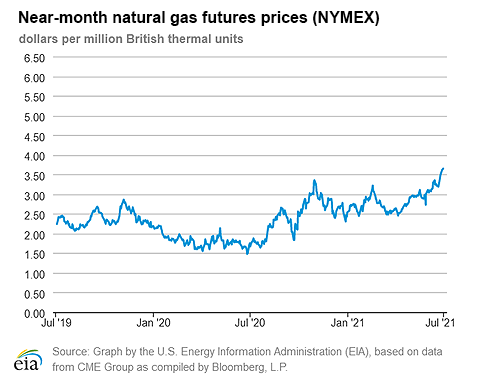
| U.S. natural gas supply - Gas Week: (6/24/21 - 6/30/21) | |||
|---|---|---|---|
Average daily values (billion cubic feet) |
|||
this week |
last week |
last year |
|
| Marketed production | 104.7 |
105.1 |
99.5 |
| Dry production | 92.7 |
93.0 |
88.0 |
| Net Canada imports | 4.9 |
4.7 |
3.9 |
| LNG pipeline deliveries | 0.1 |
0.1 |
0.2 |
| Total supply | 97.7 |
97.8 |
92.2 |
|
Source: Chart by the U.S. Energy Information Administration (EIA), based on data from IHS Markit | |||
| U.S. natural gas consumption - Gas Week: (6/24/21 - 6/30/21) | |||
|---|---|---|---|
Average daily values (billion cubic feet) |
|||
this week |
last week |
last year |
|
| U.S. consumption | 67.0 |
63.2 |
66.6 |
| Power | 38.3 |
34.7 |
37.3 |
| Industrial | 20.3 |
20.3 |
20.2 |
| Residential/commercial | 8.4 |
8.2 |
9.0 |
| Mexico exports | 6.5 |
7.0 |
5.6 |
| Pipeline fuel use/losses | 6.3 |
6.2 |
6.2 |
| LNG pipeline receipts | 11.1 |
10.0 |
4.5 |
| Total demand | 90.9 |
86.5 |
82.8 |
|
Source: Chart by the U.S. Energy Information Administration (EIA), based on data from IHS Markit | |||
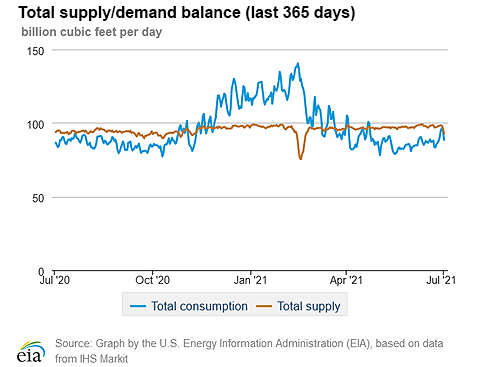
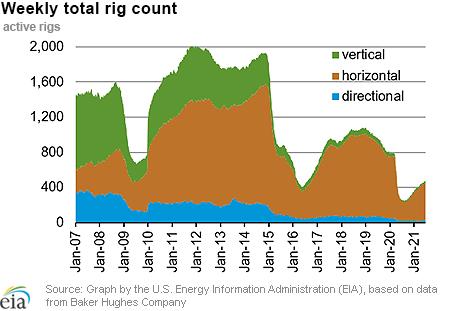
| Rigs | |||
|---|---|---|---|
Tue, June 22, 2021 |
Change from |
||
last week |
last year |
||
| Oil rigs | 372 |
-0.3% |
97.9% |
| Natural gas rigs | 98 |
1.0% |
30.7% |
| Note: Excludes any miscellaneous rigs | |||
| Rig numbers by type | |||
|---|---|---|---|
Tue, June 22, 2021 |
Change from |
||
last week |
last year |
||
| Vertical | 19 |
-5.0% |
26.7% |
| Horizontal | 421 |
-0.9% |
83.0% |
| Directional | 30 |
20.0% |
50.0% |
| Source: Chart by the U.S. Energy Information Administration (EIA), based on data from Baker Hughes Company | |||
| Working gas in underground storage | ||||
|---|---|---|---|---|
Stocks billion cubic feet (Bcf) |
||||
| Region | 2021-06-25 |
2021-06-18 |
change |
|
| East | 513 |
488 |
25 |
|
| Midwest | 623 |
595 |
28 |
|
| Mountain | 173 |
169 |
4 |
|
| Pacific | 244 |
239 |
5 |
|
| South Central | 1,005 |
991 |
14 |
|
| Total | 2,558 |
2,482 |
76 |
|
|
Source: U.S. Energy Information Administration Form EIA-912, Weekly Underground Natural Gas Storage Report | ||||
| Working gas in underground storage | |||||
|---|---|---|---|---|---|
Historical comparisons |
|||||
Year ago (6/25/20) |
5-year average (2016-2020) |
||||
| Region | Stocks (Bcf) |
% change |
Stocks (Bcf) |
% change |
|
| East | 636 |
-19.3 |
555 |
-7.6 |
|
| Midwest | 737 |
-15.5 |
631 |
-1.3 |
|
| Mountain | 172 |
0.6 |
164 |
5.5 |
|
| Pacific | 303 |
-19.5 |
281 |
-13.2 |
|
| South Central | 1,221 |
-17.7 |
1,070 |
-6.1 |
|
| Total | 3,068 |
-16.6 |
2,701 |
-5.3 |
|
| Source: U.S. Energy Information Administration Form EIA-912, Weekly Underground Natural Gas Storage Report | |||||
| Temperature – heating & cooling degree days (week ending Jun 24) | ||||||||
|---|---|---|---|---|---|---|---|---|
HDDs |
CDDs |
|||||||
| Region | Current total |
Deviation from normal |
Deviation from last year |
Current total |
Deviation from normal |
Deviation from last year |
||
| New England | 8 |
1 |
7 |
31 |
12 |
-23 |
||
| Middle Atlantic | 7 |
3 |
6 |
33 |
0 |
-22 |
||
| E N Central | 12 |
6 |
11 |
36 |
-3 |
-20 |
||
| W N Central | 8 |
2 |
5 |
56 |
4 |
3 |
||
| South Atlantic | 1 |
1 |
0 |
78 |
-3 |
2 |
||
| E S Central | 1 |
1 |
0 |
70 |
-6 |
0 |
||
| W S Central | 0 |
0 |
0 |
112 |
4 |
5 |
||
| Mountain | 2 |
-14 |
-12 |
85 |
24 |
30 |
||
| Pacific | 0 |
-11 |
-2 |
49 |
22 |
21 |
||
| United States | 5 |
-1 |
3 |
60 |
4 |
-1 |
||
|
Source: Chart by the U.S. Energy Information Administration (EIA), based on data from the National Oceanic and Atmospheric Administration Note: HDDs=heating degree days; CDDs=cooling degree days | ||||||||
Average temperature (°F)
7-day mean ending Jun 24, 2021
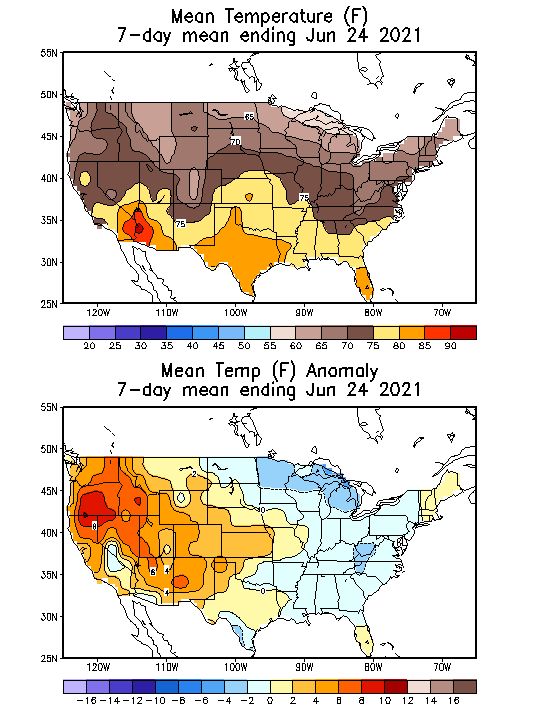
Source: National Oceanic and Atmospheric Administration
Deviation between average and normal (°F)
7-day mean ending Jun 24, 2021

Source: National Oceanic and Atmospheric Administration

